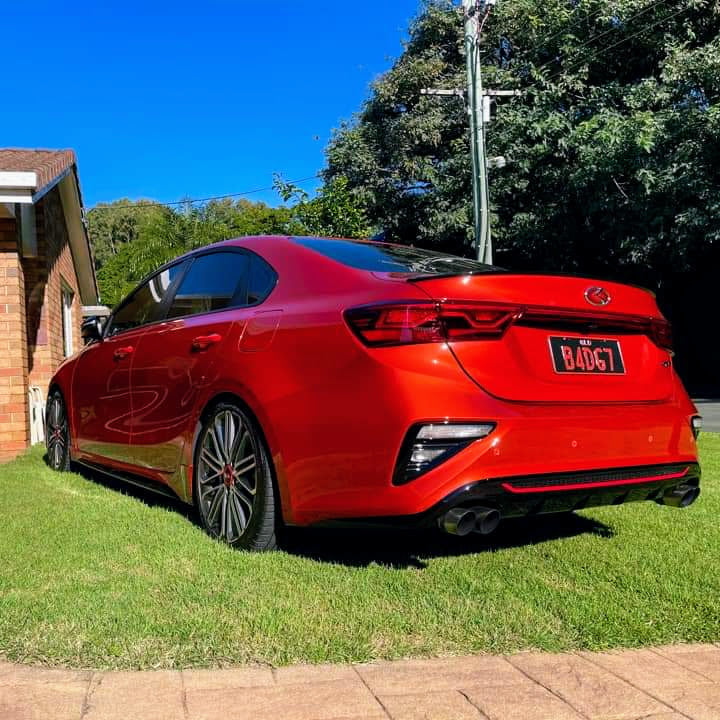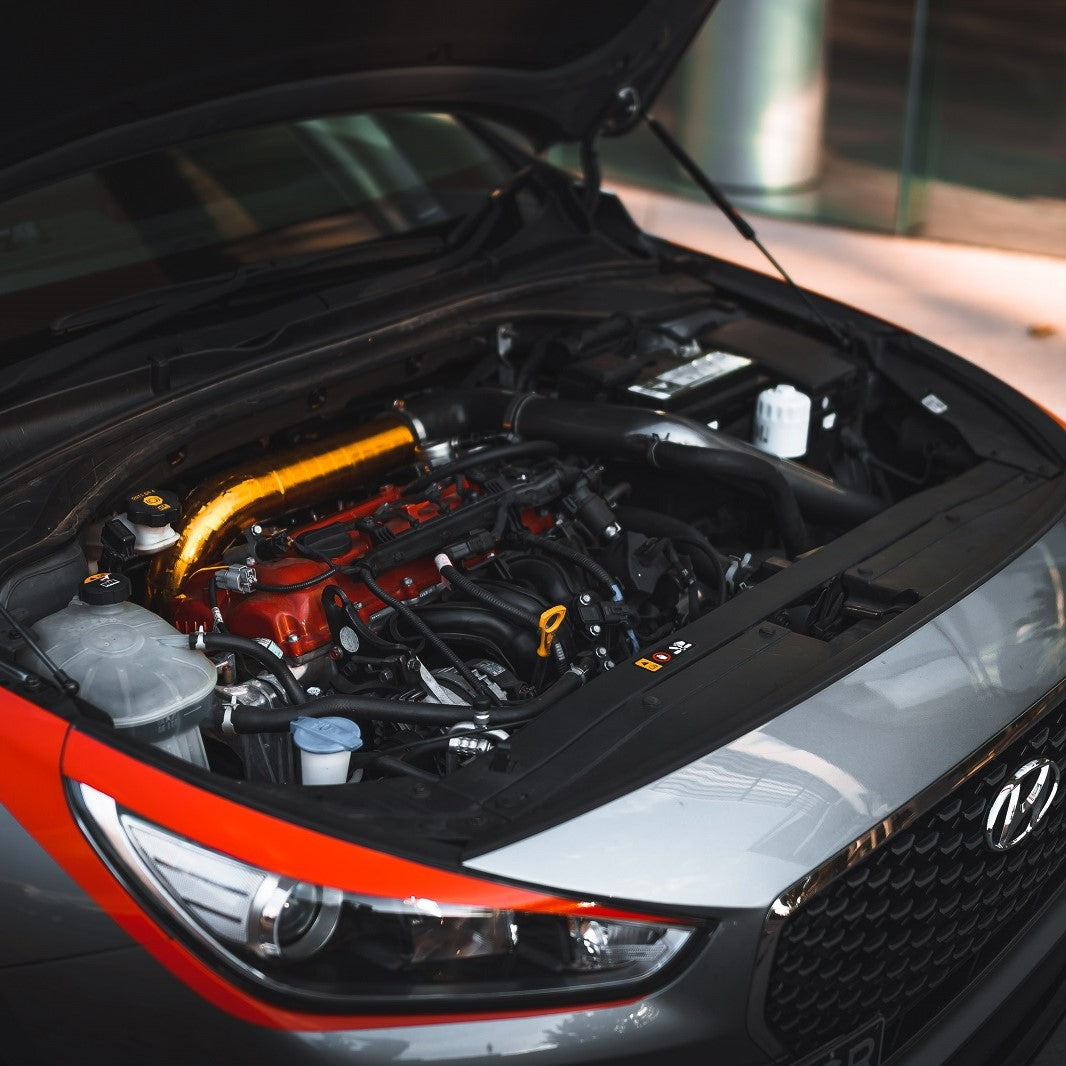We find that a lot of customers like to look at modifications for their car based on bundles of modification, commonly referred to as "stages". While we're working on a more "Cherry Centric" package solution (think something like CT300 for a 300HP kit, or something to that level), in the meantime we wanted to make our tuning recommendations a little easier to find for all KDM car owners, hence the below list!
As always, if you have any questions, don't hesitate to reach out.
The stock Cerato GT 1.6T is actually a higher compression motor than the i30 SR/N-Line, it also has a larger turbocharger with an electronic wastegate, so both boost headroom and control are better with the Cerato GT. As such, we generally expect a stock GT to make around 110-120kW at the wheels on most Australian roller dynos. Power can change from dyno to dyno which can be due to individual vehicle variation, however it also goes to show that dyno numbers are very different depending where you take your car - so take dyno numbers you see online with a grain of salt.
General Mods
Not required - but recommended
Blow off valve / Bypass valve
The factory Cerato valve is plastic and prone to leaking under heavy boost loads. Aftermarket valves don't leak. There is no difference from a performance perspective if you choose a plumb-back valve (bypass valve), or a venting valve - the only difference is if you want the 'woooosh' noise from the valve.
Oil Catch Can (specifically for the PCV)
Catch cans help to filter contaminants from the engine crank-case that are normally sucked back into the motor to be burnt off. On a direct injection motor this is particularly bad as there is no fuel washing over the valves to keep them clean. Thus a catch can can help to prolong the life and performance of a direct injection motor
Engine Pitch Mount
If you've ever tried to launch your car, especially in the wet, you would have experienced the horrible axle tramp that these cars are renowned for. A firmer lower pitch-stop mount will help to eliminate this issue at the expense of added NVH (Noise, Vibration, Harshness). This can, however, be tuned out with an increased idle.
Stage One
Expect gains of around 35-40kw and 80-120Nm
Intake
Any of the name-brand aftermarket intakes is fine. While the factory intake isn't super restrictive on these cars, the added induction noise and improved turbo response from an aftermarket intake add to the experience of the car in a cost effective way. Additionally we see lower intake temps with most aftermarket intakes, especially when paired up with a VelossaTech Big Mouth
Intercooler Resonator Delete
There is a small resonator in the intercooler piping that adds a little turbulence to the charge flow right out of the turbo compressor. Will this mod by itself make a big difference? Not necessarily, but it's a very cost effective mod, and we're building this stage to make the car more powerful and better to drive while keeping budget in mind.
2nd Cat Delete (Racepipe / Cat-back Exhaust)
The secondary cat is actually the main power restriction at this stage. Removing it adds power even without a tune and we've seen gains up to 7kW and 11Nm just from this one mod, even before a tune. You don't need a full exhaust to get this gain, you don't even need to remove the resonator, all you need to do is remove the secondary cat in the midpipe
Spark Plugs
The stock spark plugs have earnt a reputation for having their gap blown out on cars with extra boost added. It used to be a common recommendation to remove the plugs and reduce their gap down to help with this issue and to give a more consistent spark, however we're following the tuning "rule of thumb" which says you should be running one step colder for every 50HP you add to the car, so a set of HKS Super-Fire (heat range 9) plugs will not only give you a stronger spark plug, but also helps to lower cylinder temps allowing for more aggressive ignition timing in the upper RPM, which is required to make good power with such a small turbocharger.
Tune
We retune the factory ECU in the car to make sure that you're making the most of your modifications. This includes adjustments to fuel, ignition timing, boost, turbo response, idle speed, and many more. Generally speaking, tuning the ECU will instantly void your drivetrain (engine/gearbox) warranty, which a lot of owners at this stage of modifications aren't really wanting to do, as such - for stage 1 at least - running a piggyback boost controller of some kind (like the RaceChip) will allow you to experience 80% of the benefits of a proper ECU tune while being easily removable and harder to trace by the dealership.
Stage Two
Expect gains of around 45-50kw and 120-160Nm
Downpipe
The design of the factory downpipe, along with the restrictive 600CPI cat are both now representing a restriction in power and are limiting how aggressively we can tune both boost and ignition timing. Freeing up flow at the downpipe helps to not only reduce back-pressure on the turbocharger, meaning we can get much better response out of the turbo, it also adds to heat, which limits how much ignition timing we can run - time for a high flow replacement! We offer both 2.5" flange models for a stock-sized cat-back, and full 3" models for those running an aftermarket cat-back. At this power level, the 2.5" step down and smaller mid-pipe still doesn't represent a restriction to power (in fact, we still see similar numbers from cars running stock rear mufflers, so a fast car doesn't need to be a loud car)
Intercooler
As mentioned above, we're at a point where heat is our enemy in terms of chasing extra power. While an upgraded intercooler won't necessarily add a lot in terms of outright power (given we're essentially running the little turbo as hard as we can and still lucky to make 16psi at redline), what an upgraded cooler does is adds to power reliability. While the stock cooler might be fine if you're only expecting to accelerate in small bursts on cooler days, a larger and higher quality intercooler means you can drive your car harder for longer, and on hotter days, and still make the same power all the time.
Retune
We retune the car to make use of the extra flow and cooler charge, normally this means we can be much more aggressive with ignition timing, which is where all the top-end power is going to be made with such a small turbo. That said, we do normally chase an extra 1-2psi of midrange, giving the car a stronger punch between 2,500 and 4,500rpm
DCT Tune
At this point we would also recommend that you get your gearbox tuned, as the extra responsiveness and mid-range punch can cause the clutches to slip. Our DCT tune ramps up clamping force on the clutches, and shortens up shift times, making for a more aggressive and sportier driving experience.
Stage Three
Expect around 190-195kW at the wheels and over 400+ Nm of torque
Stage 3 is where we're starting to push the limit of the factory engine without being rebuilt, and we also need to be mindful of the power limit of the DCT. Quoted power figures are without building the motor, however to put this power level into perspective, this is only a little less than a tuned i30N will make with basic bolt-on mods.
High flow turbo
Stage 3 is all available bolt-on modifications, along with the addition of a high-flowed (hybrid) turbocharger. We essentially take your turbo (or supply you a new one) with all the internals bored out and replaced with much larger internals. We expect boost to be a little laggier, by a few hundred RPM, but the turbo is now able to hold a might higher peak boost well past the factory redline. In fact, we can still use this same high-flow turbo with a built motor and make an extra 20-30kW by leaning on the turbo a lot harder - so there is lots of headroom in the turbo, now your engine is the weak link.
Retune / TCU Tune
A TCU tune no longer optional, as we need to raise the rev limit to 7000rpm to make use of the extra flow from the turbocharger. We will also retune the factory computer to make use of the larger turbocharger, and increase the factory RPM limit to 7000rpm.
Further Mods / Stage 4?
At this point you're nearly at the limit of the factory motor, there is really only one other modification that you can make prior to building the motor to accept 25psi or more.
Water Methanol Injection
There are plenty of videos and articles online that outline the benefits of water/methanol injection, so this blog post isn't going to be a be-all and end-all guide on the benefits of water/methanol injection. If you're curious about using WMI on your car and want to discuss it further, head over to the contact page and give us a call!
That said, here are the main benefits of using water/methanol injection:
- It drastically lowers your intake air temps. It’s easily possible to get your intake temperatures BELOW ambient temperature, meaning your car will have that “cold weather feel” even on a hot summer day! In fact, WMI can be so effective at lowering temps that it’s possible for turbocharged cars to be run without an intercooler!
- It increases effective octane rating of fuel by as much as 20 points, meaning WMI gives you more knock resistance then race fuel or E85. Obviously, this benefit isn’t really noticeable unless you tune the car for it. By adding in additional ignition timing, increasing boost pressure, and leaning out the fuel mixture, especially when you combine this with the reduced intake temps, it’s entirely possible to see gains of 5-10% for a naturally aspirated car, and >20% for a turbocharged car.
- It cleans your intake valves and combustion chambers. This is especially important for our direct injection cars, where the only other real option is to run a catch can and clean the valves whenever you service the car. The water portion of the WMI system also helps to steam clean the engine internals, ensuring that your engine has a long and happy service life.
- You only use it when you drive hard, unlike E85 or similar. When you're cruising on the motorway, your car doesn't use any water/meth at all, as the system is only set to inject when there is boost present. In addition, it can actually decrease fuel consumption for light/medium throttle loads, as the methanol mixture will allow the ECU to inject less petrol.
- It's cheap and easy to install! This is especially if you buy your methanol in bulk.
On the downside Water/Methanol Injection systems, even if just used for water injection, is not generally considered legal for street use in Australia without certification by an Engineer. Additionally, improper installation and/or adjustment of this product can result in major engine/vehicle damage. So if you want to investigate this option, please give us a call or send us an email on the contact page.


